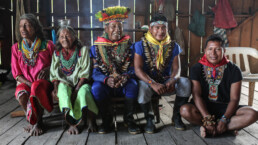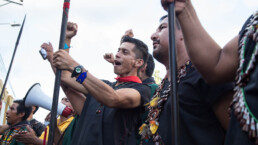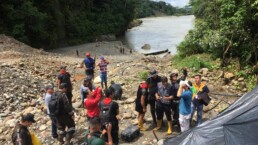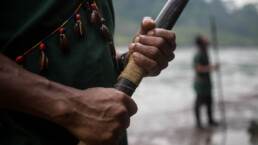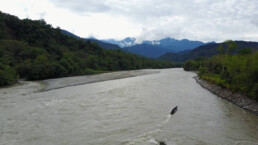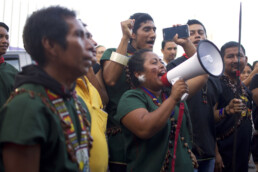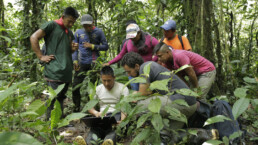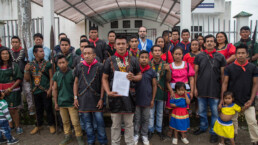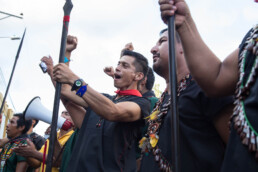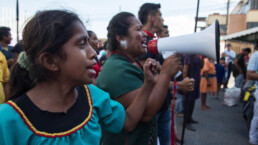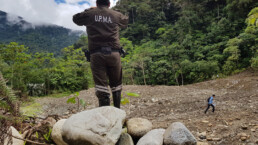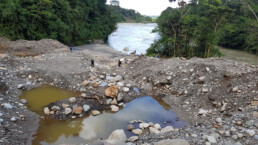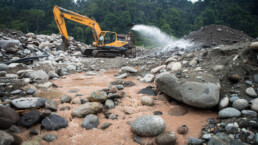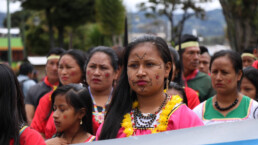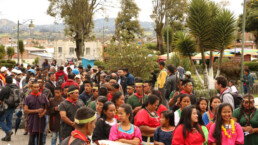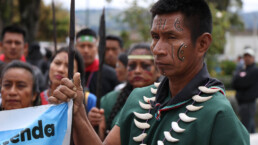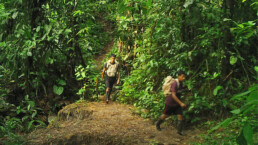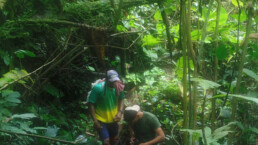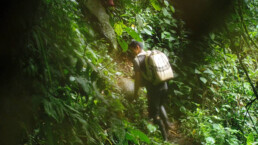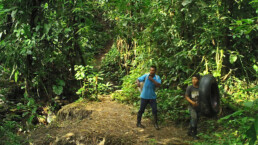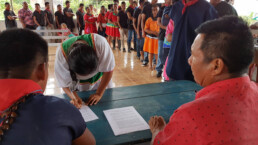“Without Unity, There Can Be No Triumph”: An Indigenous Voice on a Historic Victory Against Gold Mining In The Amazon
On this Day of International Human Rights, Alex Lucitante, a young indigenous leader from the Kofan people, shares his experiences from the frontlines of a historic victory against gold mining in ancestral Kofan territory. From reviving ancient yagé ceremonies (also known as ayahuasca) to strengthen community resistance to using technology in the defense of their land, the small community of Sinangoe’s path to victory and their struggle ahead is one marked by a fusion of innovation and ancestry – and above all, unified determination to protect their rainforest home from extractivism.

When Sinangoe’s victory happened on October 22nd 2018, I cried and felt so much emotion. It took a lot of sacrifice to get to that victory, which nullified 52 mining concessions on our ancestral territory that had been granted by the government in violation of our right to consent.
The community’s dream was what sparked this fight. Our territory gives us everything we need: it is our pharmacy, our supermarket. There lies our history, our roots, and the life that enables us to live in harmony. That is why it is so important for us to protect it, it is our home.
Mining threatened our territory. It threatened the river and the spiritual places which give us life and which teach us respect for life. For the Kofan people, the river is not just water and stones. To see a fish is to see food, and to see water is to see life in the river. If the rivers are contaminated, what will happen? In the spiritual world, when the spirits of the jungle leave us, everything else we have also gets lost. The community will no longer bother taking care of the river, because it won’t make sense. They will start working and buying things that are not from the territory, they will begin to dream with money and they will begin to destroy the territory.
“Mining threatened our territory, our rivers and the spiritual places which give us life”
Our ancestors taught us to fight with truth and respect. That helped us so much on this path. Beyond our spears, our crafts, our way of life, our language – yagé, or ayahuasca, is a deep part of our identity as Kofan. Sinangoe still does not appropriate what is proper to us. We were divided by the Evangelism or “civilization” which the Kukamas [outsiders] imposed upon us. They convinced our people that drinking yagé was diabolical. Our wisest elders were deceived and finally stopped drinking yagé.
So the youth of Sinangoe grew up without the knowledge of yagé – until this struggle began. With the community guard, we went to my father’s territory to drink yagé. We went to Siona territory, where some of the people have maintained the practice despite evangelization, and there we also drank yagé. From then onwards, some young people learned to prepare it and they now are drinking with the elders, ancestral wisdom-keepers. Then began the construction of the ceremonial house in Sinangoe earlier this year, when the community began the struggle in defense of its territory. First the struggle emerged and then the cultural recovery – and now all of this continues.
“Drinking yagé allowed for respect to grow amongst everyone, it strengthened our unity”
The main vehicle for this struggle was the unity of the community. That unity was built through hard work and difficult times because Sinangoe was previously divided by political issues, the personal interests of certain groups, and different ways of thinking. But it was not entirely divided: there was still this dream to remain united, to do something for the community and for the territory.
Drinking yagé made respect grow amongst everyone, it strengthened the unity. It made people understand that what is our is ours, and no one can take that away from us. Yagé helps you to understand your life but it is also makes you understand the life of the forest – when you hear its chants, its sounds, that is where there is life. You see mountains and you see that this is sacred land. It is where the spirit of the jaguar rests and wanders, and where the sound of the wind fuses to the forest, and this creates harmony so that everything can be well. We are not greater than the forest or our territories, we are equal, we are the same: this is the Kofan vision. And so through yagé, we become stronger on this path.
If we ask ourselves why Kofan territories or indigenous territories have been kept intact until today, and why they contain more land and biodiversity than anywhere else, it is because our ancestors cared for and defended our territories. The current community guard of Sinangoe is nothing new – it is something that has been a fact since the existence of the Kofan people; our ancestors were these guards.

But during this process of struggle, in exercise of our right to autonomy and self-governance, we saw the need to formalize this guard on paper and create a law prohibiting activities that certain groups, companies or people were doing in disrespect of the community. The community’s voice was not being heard and the State was not guaranteeing our rights. For example, there were people putting shotgun traps to hunt animals in order to sell them, throwing dynamite, poison and all kinds of chemical substances into the rivers, dredging the territory and destroying mountains… So our ancestors’ mandate applied, to defend our ancestral territory through the means of a guard, by means of our warriors.
“The State must guarantee our rights to our territories”
Technology, paired with the guard’s ancestral knowledge of our territory and how to navigate the river and adapt ourselves in the jungle, was very important in the Sinangoe case. The camera traps and drones served to document and monitor what was happening in the territory. At first, there were threats towards our leaders – “if we see you Kofan here, we will take out our machetes, we will cut off your head” – that is how the miners threatened us. But with all the photographic evidence which Sinangoe collected through camera traps and drones, we were able to file a demand for an action of protection. The denouncement was made public before the authorities, and through the media we alerted the world about the changes that were happening in our territory, about the illegal invasions but also about the mining concessions granted by the Ecuadorian government without our consent. When this happened, investigations were opened, and from then those who threatened us remained silent.

A few weeks ago, we met with the United Nations Special Rapporteur on Indigenous Rights during her visit to Ecuador. We explained how the State was not recognizing our rights to our territories as Kofan people, the State was violating our rights. We need the State to guarantee our rights through land titling. We also demanded that the State recognize the role of indigenous guards as guardians of ancestral territories and for the protection of the rainforest and biodiversity, because to this day, the State has been incapable of doing so. Instead, the State has accused us of being “paramilitaries”, “militia groups”, “accomplices of the miners”. But the Rapporteur met the guard to understand its structure and how it protects our territories: with respect, strength, and love in the heart.
Now the community is beginning a process to map out its territory, they will be walking long distances to gather evidence of sites of great importance in order to demand that the State recognize their territory through a property title. The State wants to have authority over these territories but they must respect our ancestry. With the case’s sentence and all the support and alliances that Sinangoe now has, we are confident that we will be able to secure this land title. And when we secure this land title, we will be stronger in our fight to guarantee our cultural and physical survival.
The struggle of Sinangoe doesn’t just represent the Ecuadorian Amazon. It also speaks to other countries – where indigenous peoples want to fight and confront these big issues but still feel lost because they do not really understand who they are as a people. In reality, we, indigenous peoples are subject to rights just like nature, so we must fight and defend who we are. When there is consciousness, as there is in the case of Sinangoe, people view who they are with pride and love. We raise our spears and say we are Kofan, and so what? It does not matter that we do not have the dream of the white man or of the extractivist to own a lot. We have the dream of our ancestors, which is the ancestral right to be who we are and live as we want to live. That is the message from Sinangoe to the world: get up, raise your voice, but always be united. Without unity, there will be no triumph.

List of chronicles in our series on Sinangoe:
Stopping a gold rush in the Amazon: 7 reasons why the Kofan landmark victory is so huge
Facing the mounting pressures of the global race for gold and other metals across the globe, it’s not everyday that a small indigenous community wins a lawsuit against the government that nullifies over 50 mining concessions threatening their health and land, and grants full restoration of the damages done. Last week’s landmark victory for the Kofan people of Sinangoe, at the headwaters of the Aguarico River in the Ecuadorian Amazon, is testament to the importance of indigenous-led resistance against extractivism in the world’s largest tropical rainforest.
This community’s path to victory involved a myriad of strategies ranging from environmental monitoring to innovative legal actions and alliance-building with civil society, provincial governments and international organizations. Its example should provide inspiration and tools to other indigenous peoples facing similar threats to their ancestral lands, cultures and rights. Here are 7 major reasons why Sinangoe’s case is so important.
1. It safeguards the ancestral Kofan way of life
Kofan culture is deeply connected to the land: their entire way of life depends upon the rivers and forest. When the Kofan discovered that their ancestral territory along the Cofanes and upper Aguarico rivers had been granted to mining companies without their permission, they immediately recognized the gravity of this threat to their way of life and autonomy, and to other communities downriver. Damage to these rivers means damage to the Kofan themselves. Their triumphant legal battle, which brought four Ecuadorian State authorities to court, not only denounced the lack of consultation, but also highlighted the violation of their rights to water, food security and a clean environment – fundamental rights imperative to the integrity and survival of Kofan culture.
The Kofan people of Sinangoe have won a landmark legal battle to protect the headwaters of the Aguarico River, strengthening collective rights to Free, Prior and Informed Consent over any extractive activity in indigenous lands.
2. It shows the effectiveness of indigenous-led environmental monitoring
It was Sinangoe’s community land patrol that sounded the alarm when they witnessed the first machines digging up the banks of the Aguarico River in early 2018. This land patrol, trained and formed one year before in partnership with Amazon Frontlines and our indigenous partners Ceibo Alliance, immediately documented and reported the invasion. Over the course of several field trips, the land patrol meticulously built up an extensive archive of images, drone footage and maps, which played a central role in their landmark victory, providing irrefutable evidence of the environmental damages of gold mining on their land to the judges and court. This victory should embolden any community using environmental monitoring techniques, whether it be camera traps, GPS, video recorders, drone, satellite imagery and/or land patrols.
Over the course of 2 years, Sinangoe’s land patrol have used a wide range of strategies and technologies to detect, document and stop gold mining inside and around their ancestral land.
3. It sets a legal precedent for indigenous rights in Ecuador and beyond
The decision by the Provincial Court is without precedent in Ecuador, and takes huge steps towards the protection of indigenous and environmental rights. First, there is the concrete: 20 concessions improperly granted to mining companies canceled; 32 concessions under review for approval indefinitely suspended; and full remediation of damages already caused by the mining activity. But this sentence has deeper repercussions for a country with 14 indigenous nations and some of the world’s most important natural resources. The court’s recognition that the government must consult indigenous communities when the proposed activity affects their territory, even if it doesn’t occur directly on their legally recognized land, is a huge win for indigenous rights to Free, Prior and Informed Consent. Equally important is the recognition of the rights of nature, as well as the use of the precautionary principle, always applicable but seldom-applied in Ecuador, which vests the government with the responsibility to protect the public from harm (in this case to the environment and to the right to water and food security) BEFORE irreversible damage occurs unless scientific evidence can prove otherwise. The court’s decision advances the law in Ecuador, paving the way for other communities to exercise their rights and protect their territories.
4. It protects one of the most biodiverse places on Earth from rampant deforestation
By halting all mining operations along the headwaters of one of Ecuador’s most important rivers, the Kofan have saved 32,000 hectares (79 000 acres) of the most biodiverse rainforest in the country and amongst the most biologically rich places on Earth. The area, fed by the Cofanes and Chingual Rivers, is home to over 3,725 species of plants, 650 species of birds and 50 species of mammals, including various endemic and endangered species like the spectacled bear and the mountain tapir. This biological hotspot’s fragility and uniqueness mean even limited road building and small-scale deforestation could have disastrous impacts on the local flora and fauna. This legal victory affords respite for these wild places and highlights the incompatibility of mining in this pristine Amazon rainforest.
5. It contributes to the fight against the global climate crisis
As deforestation continues to spread across the Amazon, and with the Ecuadorian Amazon having already lost 675,000 hectares of pristine rainforest since 1990, protecting intact refuges like Sinangoe’s ancestral land and its rich surroundings is key to combating climate change. Each hectare of forest in this area contains between 245 to 633 tons of carbon stored in its vegetation and soils, amongst the highest carbon densities in the Amazon1. Avoiding deforestation over 32,000 hectares of this rainforest means avoiding the release of at least 7.8 million tons of carbon to the atmosphere, or the equivalent average yearly carbon emissions of more than 1.7 million cars2.
Deforestation along the banks of the Aguarico River detected by Sinangoe’s land patrol in April 2018.
6. It avoids hazardous contamination of one of the biggest rivers in Ecuador
The Ecuadorian government granting of 52 mining concessions posed a significant threat to the Aguarico river, which crosses the entire Ecuadorian Amazon, providing water to dozens of indigenous communities and to some of the largest cities of the area. Gold mining operations in the Amazon are amongst the main causes of contamination from anthropogenic mercury, a highly toxic heavy metal contaminating water sources and causing serious health impacts for all beings. Moreover, Ecuador allows the use of cyanide for gold extraction, another toxin released into rivers that can pose a serious risk to water quality and health due to its high toxicity. Following Sinangoe’s urgent request during the lawsuit, the Aguarico, Cofanes and Chingual rivers were declared protected water resources by Ecuador’s national water authority (SENAGUA), blocking any mining and any future concessions directly on the banks of these vital rivers, a first in Ecuador.
The Kofan people of Sinangoe have succeeded in building strong ties with allies both nationally and internationally, helping them gain leverage in this fight against the Ecuadorian government.
7. It demonstrates that forging cross-cultural alliances is critical to success
This legal battle would never have been possible if the people of Sinangoe didn’t value their territory, put in long, hard hours patrolling their land, and sustain unity within the community. But that alone wouldn’t have won the battle. What Sinangoe also knew to do was connect with other communities and organizations and reach out for support where needed. Over the course of Sinangoe’s battle against gold mining, over 59 national and international organizations, 14 riparian communities of the Aguarico, the provincial and municipal governments and even the highly influential Catholic Church gave their support to the community, increasing Sinangoe’s leverage and visibility. This example shows that communities in resistance are stronger when they are united, and that cross-cultural alliances work when they are based on mutual respect and trust.
1 Bertzky, M., Ravilious, C., Araujo Navas, A.L., Kapos, V., Carrión, D., Chíu, M., Dickson, B. (2011) Carbono, biodiversidad y servicios ecosistémicos: Explorando los beneficios múltiples. Ecuador. UNEPWCMC, Cambridge, Reino Unido. http://www.unredd.net/index.php?option=com_docman&task=doc_download&gid=6148&Itemid=53
2 EPA. Greenhouse Gas Emissions from a Typical Passenger Vehicle. https://www.epa.gov/greenvehicles/greenhouse-gas-emissions-typical-passenger-vehicle
List of chronicles in our series on Sinangoe:
An unprecedented legal victory for indigenous rights in Ecuador frees up huge swath of Amazonian rainforest from gold mining
On October 22nd 2018, the Kofan people of Sinangoe in the Ecuadorian Amazon won a landmark legal battle to protect the headwaters of the Aguarico River, one of Ecuador’s largest and most important rivers, and nullify 52 mining concessions that had been granted by the government in violation of the Kofan’s right to consent, freeing up more than 32, 000 hectares of primary rainforest from the devastating environmental and cultural impact of gold mining. This precedent-setting decision will inspire indigenous nations across the Amazon and land defenders worldwide for years to come.
The Kofan people of Sinangoe, with the support of Amazon Frontlines and the Ceibo Alliance, have been successful in forcing the Ecuadorian government to cancel all mining concessions on and around their ancestral land, a groundbreaking victory for indigenous rights in Ecuador.
In a historic ruling, the Provincial Court accepted evidence of environmental impacts provided by the community of Sinangoe and the provincial ombudsman, charged the government with not having consulted the Kofan, denounced the mining operations for having violated indigenous rights to water, food and a healthy environment, and cancelled all mining activity in more than 52 concessions at the foothills of the Andes. The ruling, which cites the precautionary principle and uses Ecuador’s new law on the rights of nature, also forces authorities to set in place restoration measures in an area that had been already heavily impacted by the mining operations.
“This is a great victory for our community, for our people and for all indigenous peoples. We are not just fighting for our people, but for everyone who depends on clean water and clean air. This victory is a huge step forward for our children and for future generations. We will remain vigilant in our territory and will continue fighting until we have legal title over our entire ancestral homeland.”
– Mario Criollo, President of the community of Sinangoe.
After only 4 months of mining operations, the environmental damages we have witnessed and documented for the court case provided a strong set of evidence on how granting mining concessions in such a fragile and rich environment is totally incompatible with the Kofan way of life and the conservation efforts needed in this biodiversity hotspot. The area now freed from mining activity is one of the most biodiverse areas on Earth. It is home not only to the Kofan people who depend on its fresh water for survival, but also to more than 3,725 species of plants, 650 species of birds and 50 species of mammals.
Mining operations threaten profound and irreversible environmental and cultural damage in this ecological hotspot as well as the health of the people of Sinangoe and thousands of people in dozens of indigenous communities downstream. Further exposing this highly diverse primary forest to uncontrolled deforestation would also accelerate the global climate crisis.
The headwaters of the Aguarico River, at the core of the Kofan ancestral land and one of the main artery of the Ecuadorian Amazon, were threatened by mercury and cyanide pollution commonly used in gold mining operations in the Amazon, until the Kofan successfully blocked it by suing the Ecuadorian government.
After months of ongoing land patrols, the use of camera traps, drones and satellite imagery, as well as indigenous-driven media campaigns to raise awareness of destructive mining practices, the Kofan people, with the support from Amazon Frontlines and our indigenous partners from the Ceibo Alliance, have succeeded in demonstrating the importance of indigenous-led environmental monitoring and sustained innovative legal strategies to protect their land and rights. Sinangoe now has the important task of ensuring the ruling is respected and the measures dictated by the Courts are enforced on the ground.
“This is a major win for indigenous rights in Ecuador, and a huge wake up call to the Ecuadorian government. Before viewing the land for the minerals underneath it, the Courts now forces authorities to obtain consent from the indigenous peoples who call it home, and to properly evaluate the environmental and cultural costs of allocating such biodiverse hotspots to gold miners.”
– Maria Espinosa, Amazon Frontlines’ legal coordinator and Sinangoe’s lawyer.
List of chronicles in our series on Sinangoe:
The Kofan people ramp up the fight to protect one of the most biodiverse forests in the Amazon
In January 2018 the Ecuadorian Government concessioned off over 30,000 hectares of some of the most bio-diverse rainforest in the Amazon to an array of mining interests, precipitating a gold-mining boom in the ancestral lands of the Kofan people. There were no prior meetings. No consultation. No information provided to the Kofan villagers of Sinangoe. No permission was asked. The arrival of big machinery, water pumps and dozens of miners was the only courtesy the government gave the ancestral guardians of this biodiversity hotspot.
After months of ongoing land patrols, the use of camera traps, drones and satellite imagery, as well as innovative legal strategies and indigenous-driven media campaigns to raise awareness about destructive mining practices, the Kofan people are on the verge of winning a landmark legal battle to protect the headwaters of the Aguarico River and contribute to the national movement to strengthen collective rights to Free, Prior and Informed Consent over any extractive activity in indigenous lands.
Over 30 000 hectares of mining concessions were granted by the Ecuadorian government in the headwaters of the Aguarico River, Ecuadorian Amazon, without any Free, prior and informed consent from the Kofan community of Sinangoe.
The Kofan peoples’ ancestral rainforest homeland is a miracle of biodiversity – a headwater region where Amazonian forest ascends steep mountainous cliffs into the Andean foothills, home to more species per hectare than anywhere else in Ecuador. The Kofan people, recently featured in a Foreign Policy story about the advantages of indigenous land stewardship, are achieving international recognition for their conservation efforts – which combine cutting-edge tech, weekly land patrols, and tenacious legal advocacy.
Yesterday, the Kofan people’s efforts received an additional boost with a strongly worded letter to Ecuador’s president, Lenin Moreno, signed by 55 national and international organizations, including Greenpeace, Hivos, Amazon Watch and Rainforest Fund. The support comes after the community won a first legal battle in court against four Ecuadorian ministries back in July 2018. In this ruling, a regional judge recognized that Sinangoe’s right to free, prior and informed consent had been violated, and suspended all mining operations in the Aguarico headwaters.
“The presence of mining in the headwaters of the Aguarico River represents a threat to the health of the people of Sinangoe and thousands of people who live downstream, exposes this highly diverse primary forest to uncontrolled deforestation and accelerates the global climate crisis.” – Letter to Lenin Moreno, President of Ecuador
The decision in the lower courts was immediately appealed by all the authorities, and then by Sinangoe and their ally in the Defensoria del Pueblo, who seek an even tougher verdict recognizing that rights to health, water and a clean environment had also been violated and also that the concessions be revoked, not just suspended. The case will be brought in front of provincial judges tomorrow, September 5th 2018, where hundreds plan to gather at the Court of Appeals in the amazonian town of Lago Agrio, coming in support of the Kofan Nation and in defense of the Aguarico River, its pristine headwaters and the vital water it provides to thousands of amazonian people. Stay tuned for more on Sinangoe’s struggle.
List of chronicles in our series on Sinangoe:
Historic indigenous legal victory against gold mining in the Amazon
In a lawsuit that will inspire and galvanize many other indigenous communities across the Amazon for years to come, the Kofan of Sinangoe have won a trial against four Ecuadorian ministries and agencies for having granted or attempted to grant more than 30,000 hectares of mining concessions in pristine Amazonian rainforest on the border of their ancestral land without their free, prior and informed consent. The destructive mining operations that were taking place within these concessions threatened not only the Kofan’s lives, culture and health, but also those of the countless communities located downriver.

In a historic decision on Friday July 27th 2018, a regional judge accepted the evidence provided by the community, charged the government with not having consulted the Kofan, and suspended all mining activity in more than 52 concessions in the headwaters of the Aguarico River. The decision was immediately appealed by all the authorities involved, and then by Sinangoe and their ally in the Defensoria del Pueblo, who seek an even tougher verdict recognizing that rights to health, water and a clean environment had also been violated. The case will be brought before a provincial judge in August, 2018.
The free, prior and informed consent loophole
Like in many places around the world, the Ecuadorian government has a mining claim system built to facilitate any interested party in purchasing cheap concessions— maximizing foreign interests and accelerating the approval process. Although both Ecuador’s Mining Act and the Constitution recognize the need for Free, Prior and Informed Consent from stakeholder communities for mining operations, it is still mostly a theoretical concept ignored by Ecuadorian agencies. Hence Sinangoe’s lawsuit. According to the experts heard over the course of the legal process, the Mining ministry leaves the “consultation” to the mining company or the concession owners themselves, which in turn have no legal obligation to consult with local people, and often will perform their “consultation” through a phone call or by handing out a simple information pamphlet. In the case of Sinangoe, it was when machines started tearing up the riverbed of the Aguarico looking for gold that the community learned about the new concessions.
The entire length of the Kofan River, a symbolic water body that crosses Sinangoe’s land, has been sold to gold miners by the Ecuadorian authorities without prior and informed consent. Mining in this area would cause dramatic environmental and cultural damage.
The Environment ministry, on the other end, stipulated in the courtroom that it is not responsible for consulting with communities impacted by mining. Interestingly, according to the Mining Act, the Environment Ministry needs to grant environmental licenses before operations can begin, unless the granting process takes more than 6 months, in which case – as unbelievable as this is – the permits are automatically granted to the operators. So basically, via a very simple bureaucratic process involving nothing more than paperwork, a mining operator can very quickly obtain 20 to 25-year land claims within 6 months, while the impacted communities living downstream haven’t even heard about the concessions. This is a loophole the judge described as a violation of the right to free, prior and informed consent, a verdict that will help many other communities facing the same threats in a country where gold mining is booming.
When rigorous community monitoring pays off
Throughout the lawsuit, the ministries’ lawyers vigorously tried to destroy Sinangoe’s evidence, credibility, ownership of and ancestral claims to the land. They downplayed the environmental damage documented by Sinangoe, claiming that the Kofan aren’t impacted by the mining operations because their land is on the other side of the river and that legal mining has minimal footprint on the environment. However, Sinangoe had done what will likely inspire many other communities: they had documented every step made by the miners through rigorous and systematic monitoring using high tech mapping, filming, archiving all evidence, and then they used legal tactics to pressure every single level of government to act to stop the operations. Systematic recording of all the different types of evidence helped build a solid case against a negligent concession-granting system.
Once in the courtroom, Sinangoe had accrued such a massive body of evidence of environmental damage and inaction on the part of the government that the judge requested a field inspection, a key event that helped him understand the scale of the damage already done, showed the deep connection the Kofan have with the area transformed into mining concessions, discredited the ministries’ arguments, and also allowed him to witness the sheer beauty of the area at risk.

A first legal victory, but the battle for land and rights still rages
To the officials sitting in their offices in Quito, these concessions were nothing more than coordinates and squares on a map, but to the Kofan who live across the riverbank, the area is a place imbued with life, history, sustenance, stories and so much more. To grant concessions without experiencing the place in and of itself, either through field visits or proper consultation with the people who inhabit and use the territory, is a transgression of the inherent value of sites so rich in history and biodiversity.

Sinangoe’s strength has been put to trial, and the community’s perseverance and conviction have provided them a first legal victory and attracted support from various indigenous and human rights organization across the country. With all ministries involved appealing the judgment, the Kofan will need more strength and support to navigate the next wave of legal governmental intimidation.
Sign the pledge in support of Sinangoe and stay tuned for more on our work to defend rights, lands and life in the Amazon.
List of chronicles in our series on Sinangoe:
Sinangoe Takes Its Fight to the Courtroom
From December 2017 to February 2018, the Ecuadorian government granted more than 10 new gold mining concessions in the headwaters of the Aguarico River— a major tributary of the Amazon River and vitally important to dozens of indigenous communities downriver— most within the boundaries of the Cayambe-Coca National Park and home to ancestral Kofan people of Sinangoe. Despite its direct impact on the community, the rivers, the land and the Kofan way of life, the new mining claims were granted without any free, prior and informed consultation with Sinangoe. Miners even began operating without an environmental license or water permits and have been illegally mining outside of the concessions.

In order to defend their territory and the other indigenous communities threatened by these mining operations, Sinangoe, Amazon Frontlines and our partner organization Ceibo Alliance, organized a land patrol, training dozens of community members in GPS mapping, video, photography and even the use of aerial drones to document illegal incursions into the Kofan’s legally-titled lands. These land patrols covered thousands of hectares on foot through densely forested mountain trails and by canoe up challenging and treacherous rapids, capturing critical evidence of illegal mining activities. You can learn more about the land patrols and their efforts to combat mining from our Amazon Chronicles blog: here, here and here.
On Tuesday, an article written by a journalist who was embedded with the Kofan land patrols was published in Foreign Policy magazine. The piece presents the complex relationship between indigenous peoples and national parks, making the argument that indigenous stewardship is far more effective at protecting delicate ecosystems than turning these areas into national parks managed by the government. The Kofan people of Sinangoe are a strong example in favor of this argument. Empowered and supported with tools and training, the Kofan are defending their lands from 21st Century threats with a resolve born from their intimate and ancient connection to the land. For the Kofan, protecting this forest and these rivers is not based on a distant notion of carbon markets or UN recommendations, it is a struggle to protect their way of life passed down from their ancestors, their health and their children’s future.

Now, the Kofan are taking their battle into the courtroom. This Thursday, July 19th, the Kofan go to court against the Ecuadorian Ministry of Mining, the National Mining Regulation Agency, the Ministry of the Environment and the Secretary of Water to revoke mining concessions along the border of their land and prohibit the mining companies that have systematically violated their rights from continuing to operate. At Amazon Frontlines, we will continue our efforts to raise awareness about the Kofan’s courageous battle to protect their territory. In the meantime, sign and share the pledge to #StandWithSinangoe and help strengthen the indigenous movement for resistance and rainforest conservation– on indigenous peoples’ terms– at the headwaters of the Aguarico River.
List of chronicles in our series on Sinangoe:
Hit & Run from Illegal Miners
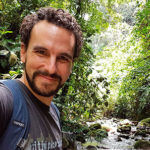
The “fluorescent” orange water coming out of the ground and flowing towards the pristine headwaters of the Aguarico River smells like a mix of sulfur and dead animals. The landscape has been ravaged, the jungle is gone, the ground has been turned inside-out, and the Provincial Prosecutor looking at the scene has trouble hiding his discomfort in front of such obvious evidence of illegal mining. This authority, the highest in the Northern Ecuadorian Amazon, is part of a delegation of the Environmental Police, the Ministry of Environment, the Ministry of Mining and the Ecuadorian Mining Regulation Agency who joined the Kofan land patrol of Sinangoe in a field visit where illegal miners had been wreaking havoc for 5 months already in this remote corner of the Amazon without being caught or sanctioned by authorities.
Alex Lucitante, a Kofan leader and human rights defender from the Ceibo Alliance, shows the Provincial Prosecutor and Ecuador’s Environmental Police a contaminated creek coming from illegal mining heading towards the Aguarico River.
Alex Lucitante, a Kofan leader and human rights defender from the Ceibo Alliance, shows the Provincial Prosecutor and Ecuador’s Environmental Police a contaminated creek coming from illegal mining heading towards the Aguarico River.
After a quick boat ride against the Aguarico’s treacherous white waters, the delegation has come to a full stop on a site that only a week ago was teaming with goldminers, excavators and water pumps. Sinangoe’s land patrol, with the support of Amazon Frontlines and the Ceibo Alliance, have found out in recent months that more than 70% of the mining operations were conducted outside of the mining concession granted by the Mining Regulation Agency back in February 2018. While the authorities observe the scene, the Kofan land rangers point to the areas where the mining camps were located the last time they had come to do their weekly patrol, but this time, only garbage and a leftover fire camp could be seen.
Described in a previous blog as a new gold rush area, the headwaters of the Aguarico have been divided into more than 30 000 hectares of mining concessions without any free, prior and informed consent from the Kofan Nation or any of the impacted communities, triggering a vast movement of solidarity and support to Sinangoe by other affected indigenous Nations living downstream. On the site, signs of illegal use of chemicals are obvious where open pools have been left untouched, those holes a clue of gold mining likely utilizing cyanide on this very site the week before, giving the riverbank a disquieting look. Along with my Kofan colleagues, we quickly come to the conclusion that the miners in the area have fled a while back, taking their digging toys with them once the news of an environmental inspection had spread like wildfire in this gold-boom area at the foothill of the Andes.
Open pools have been left untouched in an area that was teaming with miners a week before the visit. Authorities are seen inspecting one of the site on this drone clip.
Open pools have been left untouched in an area that was teaming with miners a week before the visit. Authorities are seen inspecting one of the site on this drone clip.
Pulling the government by the ears
The reason why this group of more than 20 representatives from various ministries and agencies are roasting under the Amazonian sun is not just because multiple Ecuadorian and International laws have been violated. Nor is it because the water of thousands of people living downstream is under threat from these illegal activities. In fact, the only reason we are all there together looking at the disastrous footprint of this early gold rush is because the Kofan have stood up for their land, documented every move made by the illegal miners, and then pressured every single level of government to act to stop this environmental and human rights nightmare immediately.
Flying the drone has allowed our team and the Kofan people of Sinangoe to detect and monitor the illegal miners in remote areas of the Ecuadorian Amazon. In this picture, the government authorities take a glimpse at the scene from the air through goggles.
With rigorous and systematic monitoring of every move from the miners – mapping, filming and documenting every step – the Kofan people of Sinangoe were able to demonstrate the illegality of the activities and force the Ecuadorian government to act, a first victory in a battle for the safeguard of their land. This comes after years of work for the Kofan who have decided to set in place their own indigenous law and their proper land patrol in order to detect, block and denounce any extractive activities inside their ancestral land. In the struggle to protect the Amazon, Sinangoe demonstrates the importance of indigenous-led land control in order to effectively avoid deforestation, forest degradation and poaching. Now that the authorities have finally seen the mess the Kofan have been denouncing for months, the community is waiting for action from the Prosecutor and the various ministries hoping they lead to canceling once and for all the dozens of mining concessions that have been granted in the area over the past months, and punishment for the mining companies that have operated against the law.
Damage is done, but the worst has been avoided
Over the course of 5 months of illegal mining, the trespassers have built a 2-kilometer road into pristine rainforest- opening Sinangoe’s ancestral land to more invasion. They have deforested over 15 hectares of forest, dug out countless pools, created landslides that have transformed the landscape, installed over 10 makeshift mining camps, modified the course of the Aguarico River, changed its color and turbidity and likely released a large amount of mercury and cyanide into the headwaters of this crucial Amazonian river. This neurotoxic heavy metal may cause health issues for dozens of riverine communities, contaminating the food chain for decades and accumulating into the fish those communities feed on every day.
Digging for gold with heavy machinery in the Amazon takes a heavy toll on the environment and the health of its inhabitants.
Nefarious as these impacts are, the worst has thankfully been avoided. Knowing how bad illegal gold mining in the Amazon can get pushed us to work rigorously, hard and fast to avoid the worst-case scenario. Those ⁓30 000 hectares of mining concessions have been granted for the next 25 years inside and on the borders of ancestral Kofan lands in the headwaters of the Aguarico River, an environmental bomb if it is exploited. More than ever Sinangoe needs support in order to make sure these concessions are canceled, and environmental restoration begins so the land can heal. The community has been discussing possible legal action with Ecuador’s Defensoria del Pueblo- a public institution that defends citizens’ rights- and either with them or without them will be taking legal action to protect their territory, and halt mining in the area.
These are very positive signs which needs to be reinforced. Please stand with Sinangoe to pressure the Ecuadorian government to cancel these mining concessions and respect the community’s right to free, prior and informed consent on any development activities affecting their lands, lives, or culture. By signing the pledge to #StandwithSinangoe, it allows you to add your voice to the movement, provide direct support to Sinangoe and stay informed on future important steps to protect Sinangoe’s land and rights.
List of chronicles in our series on Sinangoe:
On the frontlines of a new gold rush in the Ecuadorian Amazon

It came out of nowhere. No letters, no meetings, no publicity or any attempt to sell the idea, and from one day to the next, the game had entirely changed. With one approval from the Mining Ministry, what was once a pristine mega-diverse rainforest at the headwaters of one of the main watersheds of the Ecuadorian Amazon had been transformed into a gold mining hotspot.
The headwaters of the Aguarico River, where the Cofanes and Chingual Rivers meet, have been licensed to gold miners. The fate of the area now lies in the hands of the Kofan people who are fighting to protect one of the last intact areas of their ancestral land.
The headwaters of the Aguarico River, where the Cofanes and Chingual Rivers meet, have been licensed to gold miners. The fate of the area now lies in the hands of the Kofan people who are fighting to protect one of the last intact areas of their ancestral land.
Over the past three months, the Ecuadorian government has granted more than 10 new gold mining concessions in the headwaters of the Aguarico River, most within the boundaries of the Cayambe-Coca National Park and home to the ancestral Kofan people of Sinangoe. Despite its direct impact on the community, the rivers, the land and the A’I Kofan way of life, the new mining claims were granted without any prior consultation with Sinangoe, in violation of Ecuadorian law, and most probably without a proper environmental license.
To put it in other words, these operations are totally illegal.
The entire northern and north-eastern border of Sinangoe’s land and Cayambe-Coca National Park have been leased to gold mining interest within the past 3 months. The red areas are mining claims already conceded, the ones in green are still under revision.
A radical change of scale
As described in a previous chronicle, the community of Sinangoe has been monitoring and blocking illegal mining inside their land for years. These invasive activities had significantly dropped following a September 2017 announcement of the community’s Indigenous Law – prohibiting any extractive activities on their land – an encouraging sign for the community that had witnessed an increasing amount of colonos inside its land for years. However, this new wave of gold miners is nothing like what they have witnessed before.
Over two weeks, a patch of pristine rainforest has been transformed into wasteland by gold mining operations. The fast pace has left the community of Sinangoe fearing the worst since these new concessions have been allocated to gold miners for the next 25 years.
Large machinery, huge water pumps, road construction, massive deforestation, noisy operations, gaggles of miners…this birth of a gold rush is a radical change of scale and quite worrisome, seeing how much damage they can do in such a short time. In recent weeks, Sinangoe’s land patrol has observed diggers and large water pumps outside the mining concession limits and inside the river bed, excavating and damaging the Aguarico River. One of the community’s main concerns is that these kinds of gold mining operations in the Amazon often come with the use of highly toxic mercury, a heavy metal that bioaccumulates in fish and can be extremely damaging to the human nervous system.
Sinangoe’s land patrol has witnessed gold miners with heavy machinery digging inside the river bed, and outside their new mining concession, an illegal procedure that hasn’t been met with any sanctions by the authorities so far.
Sinangoe’s land patrol has witnessed gold miners with heavy machinery digging inside the river bed, and outside their new mining concession, an illegal procedure that hasn’t been met with any sanctions by the authorities so far.
Fueled with these new concerns, and with their struggle already attracting media attention at the international level, Sinangoe has increased its monitoring of the area and called upon the provincial and national Ecuadorian authorities to stop these operations. The Environment Ministry, the Mining Ministry, the National Prosecutor, the “Defensoría del Pueblo” and local governments have all been notified and called to action by Sinangoe.
To date, none of them appear to have taken any actions to stop these illegal activities, despite a recent referendum in Ecuador calling for a ban on any mining activities inside protected and sensitive areas. With mining being such a controversial topic in Ecuador, the country’s President Lenin Moreno announced the cancellation of 2,000 mining concessions in February, but we still don’t know if any of the concessions in the Aguarico are part of that list.
With new mining operations using heavy machinery, Sinangoe’s main concern is the high probability that miners use mercury to increase gold extraction, an illegal practice that would damage water and fish stocks and directly threaten the health of thousands of indigenous communities downstream.
Sinangoe joining forces with other mining-impacted communities
On Monday April 16th, more than half of Sinangoe’s population joined a national protest against mining, calling upon the government to cancel all new mining concessions and stop all operations in the headwaters of the Aguarico River.
Members of the Kofan community of Sinangoe took to the streets of Tulcan, Ecuador, along with other communities affected by mining across northern Ecuador, to denounce a recent wave of mining concessions that threaten their health and their territories. Sinangoe and many indigenous communities across Ecuador are standing up against extractive industries that place a higher value on profits than indigenous lives and lands.
To succeed in nullifying these concessions, Sinangoe needs to increase pressure on the Ecuadorian authorities, and your support can make the difference to turn the tables and ensure that Sinangoe’s pristine ancestral rainforest stays intact. Stand with Sinangoe by signing the pledge and by sharing this information with family, friends and colleagues, and stay tuned for further updates and actions to support Sinangoe in their efforts to defend their ancestral homeland..
Watch and share this powerful video about Sinangoe’s community-led efforts to detect and halt illegal activities on their lands.
List of chronicles in our series on Sinangoe:
Confronting illegal mining in ancestral Kofan land, Ecuadorian Amazon

The waves of the Upper Aguarico River are crashing on both sides of our boat, filling it with cold water rushing straight from the Andes, which stand tall in front of us. The puntero barks and points directions to the motorista in order to avoid smashing into one of the many boulders in our way, and my heart pumps fast with the adrenaline rush. My eyes feast on the wild landscape while my mind races: Where are they? Will we meet the same ones? How should we react if they become aggressive?
The land patrol of Sinangoe travels up the Aguarico River towards an area known to the Kofan people as a “hotspot” for illegal gold mining, hoping to stop what seems to have become an “Amazonian Gold Rush” on their ancestral land.
The land patrol of Sinangoe travels up the Aguarico River towards an area known to the Kofan people as a “hotspot” for illegal gold mining, hoping to stop what seems to have become an “Amazonian Gold Rush” on their ancestral land.
It is the fifth time in a little more than a month that our team has traveled to this far corner of the Amazon, in the mega-diverse foothills of the Ecuadorian Andes. This area has been the traditional Kofan territory of Sinangoe since time immemorial, more recently designated by the Ecuadorian government as the Cayambe-Coca National Park. If you close your eyes and think of the Amazon, Sinangoe represents everything you can imagine: rich indigenous culture, splendid wildlife, ancient lianas and giant trees, beautiful landscapes… And a lot of rain, falling in sporadic downpours and fueling hundreds of streams, waterfalls and rivers.
However, behind the luxuriant curtain of the jungle, hides a disconcerting reality: While the patch of green that represents the National Park might look nice on a map, illegal miners, fishermen and poachers are currently roaming inside Sinangoe’s land without consent from the community or any meaningful control from the government — and the Kofan people have had enough. Our team, composed of Sinangoe’s leaders and land defenders, is on the lookout.
Monitoring the elusive “homo illegalis”
We have reached the section of the river where boats can go no further, and are now walking on a trail that seems to be used every day by dozens of people. Footprints in the mud, an oddly broken branch, new trails leading deeper in the jungle, an empty shotgun cartridge, remnants of a makeshift camp, garbage left in a clearing… The signs of the “Amazon gold rush” are obvious, even for a foreigner like me. The Kofan people have been walking these woods for millennia, but rarely have they seen so many indications of the ongoing occupation of their land by the “cucamas”- the “outsiders.”
Facing increased pressure on their land, the Kofan people of Sinangoe have decided to work with the Ceibo Alliance and Amazon Frontlines in a monitoring project aimed at detecting, documenting and denouncing illegal activities in their traditional territory. Through the use of community land patrols, camera trap photos and videos, drone footage, satellite imagery and territorial mapping, the community is channeling reliable, evidence-based, real-time information about invaders to help decision-making processes in order to defend their ancestral land.
The team of Kofan land defenders from Sinangoe has been using camera traps, drones, GPS and video cameras to detect illegal activities on their ancestral land.
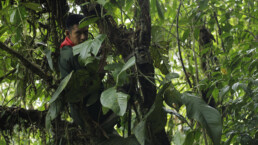
The team of Kofan land defenders from Sinangoe has been using camera traps, drones, GPS and video cameras to detect illegal activities on their ancestral land.
After walking for fifteen minutes, we reach the first camera trap, well hidden in the trees. Trepidation takes over our team. Since we installed the camera two weeks ago, it has been very active: The small lcd screen indicates that the memory card is filled with 168 pictures and videos. Triggered by movement and equipped with heat sensors, these camera traps are usually used to detect wildlife, but we have adapted our monitoring to detect another kind of species: homo illegalis- the illegal colonist invader. And it seems our first camera of the day will provide very valuable clues on the habits of this elusive species.
Settled on a big rock close to a stream, the team focuses on the laptop we downloaded the images onto, hoping the approaching rain clouds above don’t bring a quick end to our improvised forest desk. Flipping through the gallery, the faces of my Kofan colleagues change from excitement to awe to indignation. The pictures and videos show dozens of intruders on this very spot, walking in pairs or in groups of up to eight people, some with gasoline tanks, others with shotguns, shovels or pickaxes, all heading upriver at dawn and coming back down at dusk, sometimes two or three days after they first walked by.
Over the course of less than four months of monitoring, from February to May 2017, the Kofan people of Sinangoe have detected more than 70 people, often working in groups, participating in illegal activities on their ancestral land.
We’re snacking on crackers as we look at the faces of the illegal miners and poachers on the screen while the elders of the group give us information as to who these people are. Some of them are well known colono neighbors of Sinangoe, but many faces are unknown to the team, a sign that things might be getting out of control. Moreover, some of the illegal miners that triggered our camera traps have been previously warned by our team many times yet continue to show up. It seems like the message still isn’t getting across.
When words don’t mean anything anymore
We are back on the trail, going upstream along the Upper Aguarico River, when someone in our group stops, pointing with his finger to his ear. We all stop and listen carefully. At first, I can hear nothing else other than the constant variety of jungle sounds- crickets, birds, cicadas and frogs. But after a while I catch it, behind the general din, a humming sound that can only be coming from one thing: a motor. We decide to go to the river bank, towards the sound.
One of our team members sees something move, about 500 meters from where we are standing. Instead of going right away to confront whomever it might be, we decide to fly the drone and get a peek of what is going on upstream. After a two-minute flight, the drone shows us the source of the noise. On a small stream leading to the main River, deep into Sinangoe’s ancestral land, three men are illicitly digging the pristine shore with a dredger in the hope of finding gold. Having visited this site two weeks earlier, we can see that they have transformed the landscape considerably.
Caught by our drone hiding in the trees, a group of illegal miners are dredging a small catchment of the Upper Aguarico River, deep into ancestral Kofan land and inside the Cayambe-Coca National Park.
Caught by our drone hiding in the trees, a group of illegal miners are dredging a small catchment of the Upper Aguarico River, deep into ancestral Kofan land and inside the Cayambe-Coca National Park.
Even though we are filming from a considerable height, it seems the miners have heard the drone and hurry to hide in the trees. We bring the drone back to us, and decide to go straight to the men to have a talk. After a five-minute walk, we arrive at the dredger, which had been shut down, and realize the illegal miners are actually the same ones who told us a week-and-a-half ago that they never used machinery and would not come back to the area.
There is obvious discomfort in the air.
Sinangoe’s land patrol has warned dozens of illegal goldminers in the past months, asking them to respect their ancestral land and not exploit resources without their consent. In this exchange, a goldminer responds to the question “why are you coming to the very place the community says not to come, where the government says not to come and where you have no permit to do such mining?” The answer: “Let’s be honest, we are taking advantage of the situation… but give us one last chance and we will leave”.

Sinangoe’s land patrol has warned dozens of illegal goldminers in the past months, asking them to respect their ancestral land and not exploit resources without their consent. In this exchange, a goldminer responds to the question “why are you coming to the very place the community says not to come, where the government says not to come and where you have no permit to do such mining?” The answer: “Let’s be honest, we are taking advantage of the situation… but give us one last chance and we will leave”.
From what we see, the men have been at work for many days. We can make out their makeshift camp in the trees, not far away. Once again, we all sit to have a talk — the Kofan always polite and calm; the miners, apologetic and defensive. Why are they coming back to the very place where the Kofan asked them not to come? Their answer is quite straightforward: “Let’s be honest, we are taking advantage of the situation… But give us one last chance and we will leave”.
The problem is, this conversation sounds like a broken record, and everyone in the group knows it.
Indigenous legal strides against colonists’ illegal mining
Fed up with these kinds of encounters and of so many other abuses over the years, and the total lack of support from Ecuadorian authorities, the community of Sinangoe decided in May 2017 to adopt its own indigenous law and to put in place a formal land patrol to monitor and stop illegal activities on their land. Made public in September 2017, this new legal tool, supported by Ecuadorian Constitution and international treaties, prohibits any mining, poaching, fishing or logging by non-Kofan people on their land and sets strict rules on how invaders should be treated.
The entire community of Sinangoe have unanimously adopted its indigenous law in May 2017 in order to stop illegal activities inside their ancestral land.
As a direct response to these legal strides and the publicity it attracted, the local, provincial and national authorities have been forced to react, starting investigations and going with Sinangoe’s land patrol on the field to witness the illegal activities with their own eyes. Unfortunately, to this date, not one authority – either from the Ministry of the Environment, the “Defensoria del Pueblo” or the local or National Police – have acted against any of the invaders or set any sanctions.
However, illegal miners have since had to think twice before crossing into Sinangoe’s land, and the community has observed a drastic drop in invasive activities since they publicized their law in September 2017. Meanwhile, the land patrol keeps on walking their woods, constantly on the lookout for any infringement on their ancestral land.
In the early months of 2018, Sinangoe’s land patrol have found what they have feared for years: it seems like the reputation of the area as a good “gold spot” has reached bigger players’ ears. From one day to the next, big machinery has appeared on the very edge of their land, new mining concessions have been granted without any prior consultation. Definitely, this fight is far from over…
For the Kofan of Sinangoe, standing up in defense of their territory requires courage and it requires solidarity. Stand with Sinangoe by signing and sharing our pledge.
List of chronicles in our series on Sinangoe:

